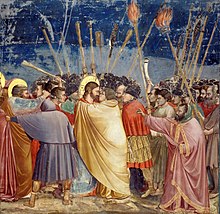
Back Judas Iskariot Afrikaans Chudas Escariot AN يهوذا الإسخريوطي Arabic ܝܗܘܕܐ ܣܟܪܝܘܛܐ ARC يهوذا الاسخريوطى ARZ Jude Iscariot BCL Іуда Іскарыёт Byelorussian Юда Іскарыёт BE-X-OLD Юда Искариотски Bulgarian ঈষ্করিয়োতীয় যিহূদা Bengali/Bangla
Judas Iscariot | |
|---|---|
 Judas' Remorse (1880) by Almeida Júnior | |
| Personal | |
| Born | 1st century |
| Died | AD 31 |
| Cause of death | Suicide by hanging or accidental death from fall |
| Religion | Christianity |
| Parent | Simon Iscariot (father) |
| Known for | Betraying Jesus |

Judas Iscariot (/ˈdʒuːdəs ɪˈskæriət/; Biblical Greek: Ἰούδας Ἰσκαριώτης Ioúdas Iskariṓtēs; Hebrew: יהודה איש קריות Yəhūda ʾĪš Qǝrīyyōṯ; died c. 30 – c. 33 AD) was—according to Christianity's four canonical gospels—a first-century Jewish man[1] who became a disciple and one of the original Twelve Apostles of Jesus Christ. Judas betrayed Jesus to the Sanhedrin in the Garden of Gethsemane by kissing him on the cheek and addressing him as "master" to reveal his identity in the darkness to the crowd who had come to arrest him in exchange for 30 pieces of silver.[2] Like Brutus, his name is often used synonymously with betrayal or treason.
The Gospel of Mark gives no motive for Judas's betrayal but does present Jesus predicting it at the Last Supper, an event also described in all the other gospels. The Gospel of Matthew 26:15 states that Judas committed the betrayal in exchange for thirty pieces of silver. The Gospel of Luke 22:3 and the Gospel of John 13:27 suggest that he was possessed by Satan. According to Matthew 27:1–10, after learning that Jesus was to be crucified, Judas attempted to return the money he had been paid for his betrayal to the chief priests and hanged himself.[3] The priests used the money to buy a field to bury strangers in, which was called the "Field of Blood" because it had been bought with blood money. The Book of Acts 1:18 quotes Peter as saying that Judas used the money to buy the field himself and, he "[fell] headlong... burst asunder in the midst, and all his bowels gushed out." His place among the Twelve Apostles was later filled by Matthias.
Due to his notorious role in all the gospel narratives, Judas remains a controversial figure in Christian history. His betrayal is seen as setting in motion the events that led to Jesus's crucifixion and resurrection, which, according to traditional Christian theology brought salvation to humanity. The Gnostic Gospel of Judas—rejected by the proto-orthodox Church as heretical—portrays Judas's actions as done in obedience to instructions given to him by Jesus, and that he alone amongst the disciples knew Jesus's true teachings. Since the Middle Ages, Judas has sometimes been portrayed as a personification of the Jewish people, and his betrayal has been used to justify Christian antisemitism.[4]
- ^ "Judas Iscariot | Biography, Last Supper, & Facts | Britannica". www.britannica.com. 18 March 2024. Retrieved 17 April 2024.
- ^ Matthew 26:14, Matthew 26:47, Mark 14:10, Mark 14:42, Luke 22:1, Luke 22:47, John 13:18, John 18:1
- ^ "Matthew", The King James Bible, retrieved 15 June 2023
- ^ Gibson, David (9 April 2006). "Anti-Semitism's Muse; Without Judas, History Might Have Hijacked Another Villain". The New York Times.
© MMXXIII Rich X Search. We shall prevail. All rights reserved. Rich X Search